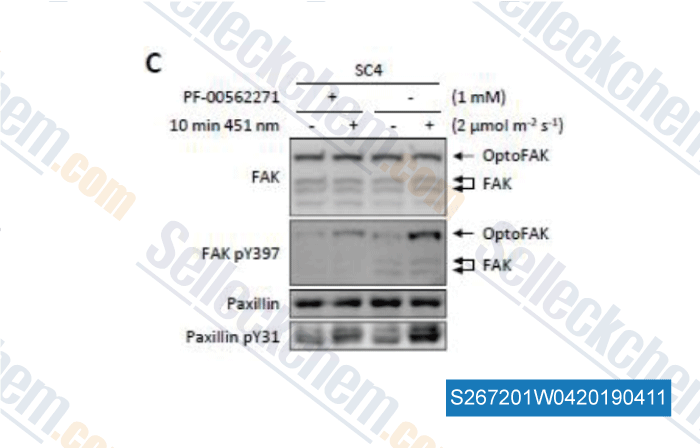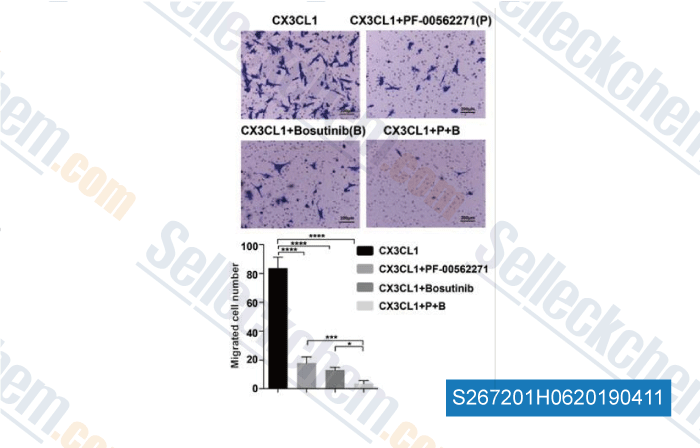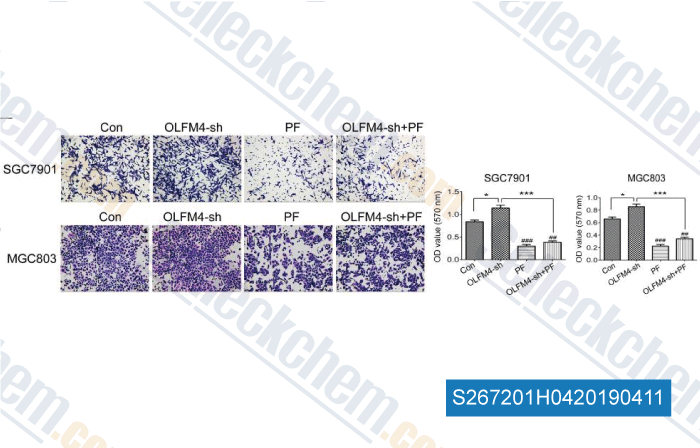|
Toll Free: (877) 796-6397 -- USA and Canada only -- |
Fax: +1-832-582-8590 Orders: +1-832-582-8158 |
Tech Support: +1-832-582-8158 Ext:3 Please provide your Order Number in the email. |
Technical Data
| Formula | C21H20F3N7O3S.C6H6O3S |
||||||
| Molecular Weight | 665.66 | CAS No. | 939791-38-5 | ||||
| Solubility (25°C)* | In vitro | DMSO | 100 mg/mL (150.22 mM) | ||||
| Water | Insoluble | ||||||
| Ethanol | Insoluble | ||||||
| In vivo (Add solvents to the product individually and in order) |
|
||||||
|
* <1 mg/ml means slightly soluble or insoluble. * Please note that Selleck tests the solubility of all compounds in-house, and the actual solubility may differ slightly from published values. This is normal and is due to slight batch-to-batch variations. * Room temperature shipping (Stability testing shows this product can be shipped without any cooling measures.) |
|||||||
Preparing Stock Solutions
Biological Activity
| Description | PF-562271 Besylate is the benzenesulfonate salt of PF-562271, which is a potent, ATP-competitive, reversible inhibitor of FAK with IC50 of 1.5 nM, ~10-fold less potent for Pyk2 than FAK and >100-fold selectivity against other protein kinases, except for some CDKs. Phase 1. | |||||||||||
|---|---|---|---|---|---|---|---|---|---|---|---|---|
| Targets |
|
|||||||||||
| In vitro | PF-562271 Besylate shows the selective inhibitory effects on FAK and Pyk2 tyrosine kinase activity with IC50 of 1.5 nM and 14 nM, respectively. And in cell-based assays, the IC50 of PF-562271 is shown to be 5 nM for FAK, which is more selective compared to other kinase targets. [1] In 2 dimensional (2D) cultures, PF-562271 results in a dose-dependent cell proliferation inhibition in FAK WT, FAK−/− and FAK kinase-deficient (KD) cells with IC50 of 3.3 μM, 2.08 μM and 2.01 μM, respectively. [2] | |||||||||||
| In vivo | In several human s.c. xenograft models, PF-562271 exhibits dose-dependent tumor growth inhibition, and produces maximum tumor inhibition for PC-3M, BT474, BxPc3, and LoVo ranging from 78% to 94% inhibition at doses of 25 to 50 mg/kg twice daily, without weight loss, morbidity, or death. [1] PF-562271 (25 mg/kg by p.o.) leads to a significant decrease in tumor progression in both subcutaneous and bone metastasis PC3M-luc-C6 xenograft models. [3] In a Huh7.5 hepatocellular carcinoma xenograft model, combination therapy of sunitinib and PF-562271 targets angiogenesis and tumor aggressiveness, and produces more significant anti-tumor effect than single agent by blocking tumor growth and impacting the ability of the tumor to recover upon withdrawal of the therapy. [4] |
Protocol (from reference)
| Kinase Assay: |
|
|---|---|
| Cell Assay: |
|
| Animal Study: |
|
References
Customer Product Validation

-
Data from [Mol Ther, 2012, 20(5), 972-83]

-
Data from [Data independently produced by , , Cell Signal, 2018, 42:176-183]

-
Data from [Data independently produced by , , J Cancer, 2018, 9(19):3603-3612]

-
Data from [Data independently produced by , , BMB Rep, 2015, 48(11):630-5]
Selleck's PF-562271 Besylate has been cited by 26 publications
| The PMA phorbol ester tumor promoter increases canonical Wnt signaling via macropinocytosis [ Elife, 2023, 12RP89141] | PubMed: 37902809 |
| The PMA Phorbol Ester Tumor Promoter Increases Canonical Wnt Signaling Via Macropinocytosis [ bioRxiv, 2023, 2023.06.02.543509] | PubMed: 37333286 |
| Pharmacological Inhibition of FAK-Pyk2 Pathway Protects Against Organ Damage and Prolongs the Survival of Septic Mice [ Front Immunol, 2022, 13:837180] | PubMed: 35178052 |
| pncCCND1_B Engages an Inhibitory Protein Network to Downregulate CCND1 Expression upon DNA Damage [ Cancers (Basel), 2022, 14(6)1537] | PubMed: 35326688 |
| A Systems Biology Approach to Investigate Kinase Signal Transduction Networks That Are Involved in Triple Negative Breast Cancer Resistance to Cisplatin [ J Pers Med, 2022, 12-81277] | PubMed: 36013226 |
| FNDC5/irisin facilitates muscle-adipose-bone connectivity through ubiquitination-dependent activation of runt-related transcriptional factors RUNX1/2 [ J Biol Chem, 2022, S0021-9258(22)00119-3] | PubMed: 35124008 |
| Milk fat globule EGF factor 8 restores mitochondrial function via integrin-medicated activation of the FAK-STAT3 signaling pathway in acute pancreatitis [ Clin Transl Med, 2021, 11(2):e295] | PubMed: 33634976 |
| Metabolic radiolabeling and in vivo PET imaging of cytotoxic T lymphocytes to guide combination adoptive cell transfer cancer therapy [ J Nanobiotechnology, 2021, 19(1):175] | PubMed: 34112200 |
| Synthesis and evaluation of FAK inhibitors with a 5-fluoro-7H-pyrrolo[2,3-d]pyrimidine scaffold as anti-hepatocellular carcinoma agents [ Eur J Med Chem, 2021, 223:113670] | PubMed: 34214842 |
| Piezo1 Channels Contribute to the Regulation of Human Atrial Fibroblast Mechanical Properties and Matrix Stiffness Sensing [ Cells, 2021, 10(3)663] | PubMed: 33809739 |
RETURN POLICY
Selleck Chemical’s Unconditional Return Policy ensures a smooth online shopping experience for our customers. If you are in any way unsatisfied with your purchase, you may return any item(s) within 7 days of receiving it. In the event of product quality issues, either protocol related or product related problems, you may return any item(s) within 365 days from the original purchase date. Please follow the instructions below when returning products.
SHIPPING AND STORAGE
Selleck products are transported at room temperature. If you receive the product at room temperature, please rest assured, the Selleck Quality Inspection Department has conducted experiments to verify that the normal temperature placement of one month will not affect the biological activity of powder products. After collecting, please store the product according to the requirements described in the datasheet. Most Selleck products are stable under the recommended conditions.
NOT FOR HUMAN, VETERINARY DIAGNOSTIC OR THERAPEUTIC USE.
